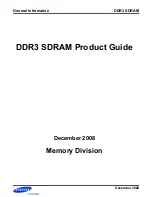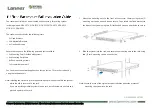
All disclosures, notices and warranty conditions are being written on the EKWB website. Please read terms of use. Released on 7
th
of March, 2013. Revision 1.0
2. PLACING BLOCK TO GRAPHIC CARD
. Carefully position the water block
with preinstalled 2.5mm standoffs on to the graphics card. During this process
please make sure you align mounting holes on PCB with holes on the water block.
Also pay attention not to use too much force by pressing block down to PCB. Chip
dies are prone to cracking.
3A. ATTACHING BLOCK AND ASUS BACKPLATE TO GRAPHIC CARD
. By using Philips
screwdriver screw in enclosed M2.5 DIN7985 screws, washers and M2.5 nuts. EKWB
recommends the following procedure:
1.
Place the ASUS factory backplate onto the graphics card circuit board
2.
Screw in four (4) M2.5x4 DIN7985 screws around the GPU core. Do not tighten the
screws firmly just yet.
3.
Start screwing six (6) M2.5x6 DIN7985 screws to secure the backplate to the water
block.
4.
Once all ten (10) M2.5x4 & -6 screws are in position tighten the screws completely.
5.
Screw in the remaining four (4) M2.5x8 DIN7985 screws (which go through PCB)
and secure them with M2.5 nuts. Use PVC washer underneath each nut!
3B. ALTERNATIVE MOUNTING OPTION WITHOUT USING ASUS
BACKPLATE.
By using Philips screwdriver screw in ten (10) enclosed M2.5x4
DIN7985 screws into each and every standoff on the water block. EKWB
recommends start screwing the screws around the GPU core and continue
outwards.
STEP 4: CHECKING FOR CONTACTS
If necessary temporarily remove the water block to check for uniform surface contact between the block and the components, pay special attention to the VRM section of the
graphics card. Check whether the water block makes contact with the intended integrated cirucit. Then repeat sub-steps in previous section to re-attach the block.
In case you
fail to obtain good contact, please check again your thermal pad thickness or contact our support service at http://www.ekwb.com/support.
STEP 5: REPLACING THE ORIGINAL I/O BRACKET
STEP 6: INSTALLATION OF FITTINGS AND TUBING
Remove the four (4) screws and four (4) hexagonal nuts securing the original
three-slot I/O bracket to the circuit board. Replace the original I/O bracket with
enclosed EK FC7970 DCII I/O bracket and install it using the original screws.
Screw in the two G1/4 threaded male fittings. Attach the liquid cooling tubes and connect
the water-block(s) into the cooling circuit.
EKWB recommends using EK-PSC fittings
with the EK-FC7970 Matrix series water blocks
. To ensure that the tubes are securely
attached to the barb/fittings, please use hose clamps or an appropriate substitute.
You can use any opening as an inlet/outlet port.
CAUTION:
In case of using connectors other than EK-PSC series compression fittings take
special attention to the length of the fittings’ male G1/4” thread. In case the thread is longer
than 5mm please use the enclosed 1.8mm nickel plated distancer! 5mm is the maximum
allowed G1/4” thread length!
STEP 6: FINISHING INSTALLATION - INSERTING THE GRAPHICS CARD IN YOUR PC CHASSIS
At this point you may carefully lift your graphics card with installed block and insert it in your PC’s motherboard PCI-express expansion slot. Please bear in mind that your graphics card is probably heavier than when it was
equipped with original heat sink fan assembly. One needs to be very careful when handling the graphics card. Avoid all un-needed manipulation of the VGA/water block assembly that might damage your card or water
block during final installation.
REQUIRED TOOLS:
scissors
philips screwdriver
EK-PSC Fitting
Tubing
EK-Plug G1/4
Acetal Terminal
ASUS factory I/O bracket
Plastic washer
M2.5x8 screw
M2.5x6 screw
M2.5 nut
M2.5x4 screw



















